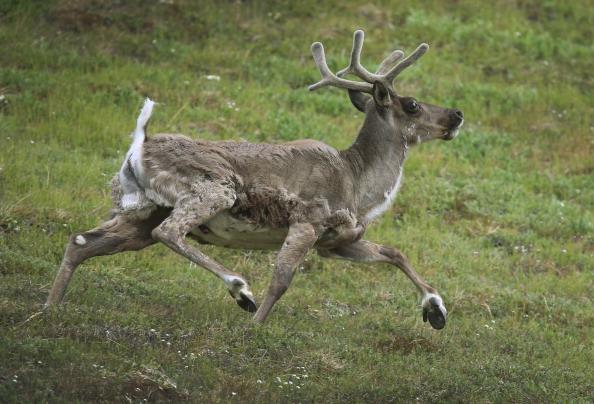If you know a child who is eagerly anticipating the arrival of Santa’s reindeer, you might not want to hear this: reindeer– or as they are known in North America, caribou—are on the front lines of a rapidly changing Arctic.
Caribou are the nomads of the Arctic, tracing seasonal migration routes across hundreds, and in the case of the Alaska and Yukon herds, thousands of miles. As the northernmost-ranging member of the deer family, caribou have a number of adaptations for tundra life. They have a thick, two-layer coat: a wooly undercoat and an outer coat of hollow guard hairs that trap air for insulation. Their muzzle is specialized to help warm the air before it reaches their lungs. They also have large, broad hooves that provide traction on spongy, boggy tundra ground in summer, and have a sharp-edged rim to help them break through snow to reach food.
In Canada and Alaska, caribou gather into huge herds in spring and fall to travel between their winter and summer feeding grounds. They spend the winter in the boreal forest to the south, feeding on lichens among the spruce and fir trees. In spring, they move back to the coastal plain, feeding first on nutritious grass-like plants called sedges during the calving period. As summer progresses and the sedges begin to die back, caribou shift their diet more to the many low-growing shrubs found on the tundra.
The Arctic is warming faster than any other part of the world, and caribou are feeling the impacts in all seasons. The time each spring when plants begin to sprout new growth is occurring earlier now, which means in some places the migrating herds are getting there too late. When they arrive to give birth and raise their calves, they have already missed the best growth of the most nutritious plants. In summer, warmer temperatures are leading to more biting flies and mosquitoes, and the scourge of blood-sucking insects is enough to interfere with feeding. And in autumn and winter, the warmer temperatures are actually making winters harsher. Warmer air holds more moisture, and so winters are seeing more snow, and even worse, more freezing rain and ice storms. These leave a thick, icy crust over the ground, forcing the animals to work much harder to break through in order to reach food.
The combined effects of the climate threat have been disastrous for a number of the major caribou herds: The most recent census found that only three of the 24 major populations are increasing, and four are stable at high levels. Six are stable but lower than usual, and eleven are decreasing. Researchers have documented a nearly 60% decline of caribou worldwide over the past three decades. Alaska’s Western Arctic Herd was about 30% smaller in 2011 than in 2003. Nine of the eleven major Canadian herds have also dropped precipitously, and are down by 50- 90% since the early 1990s.
What does the future hold for the beloved reindeer? The world isn’t exactly mobilizing to protect them and their Arctic habitat from climate change and other threats. In fact, last week’s climate talks in Peru ended with only a very weak and nonbinding deal. And the incoming chair of the Senate Energy and Natural Resources Committee has signaled that she wants to make matters worse for caribou by opening an important part of their habitat in the Arctic National Wildlife Refuge to oil drilling. Santa may have to put a whole lot of people on the “naughty” list this year.
This article was originally written and published by Aimee Delach, the Senior Climate Adaptation Policy Analyst at Defenders of Wildlife. For the original article and more information, please click HERE.
